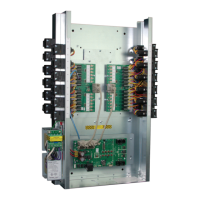8
GROUPS, SCHEDULES, AND MACROS
A group allows you to control one or more relays in one or more panels. Each group has seven parameters that will determine the
normal hours/after hours behavior of the relay(s):
Parameter Definition
Blink Amount of minutes load stays ON, when a scheduled event occurs that switches the load OFF when
transitioning from Normal Hours to After Hours. The relay will turn off and on once, then the Override LED for
that relay will blink continuously for the time period. The LEDs for all switches bound to that group will also
blink continuously. Pressing the button will keep the load ON and the time delay countdown will start. When
the countdown reaches 0, the blink function re-occurs.
NOTE: Blink does not apply when transitioning from After Hours to Normal Hours.
Time Delay NH If a load is commanded to turn ON when the schedule switches to Normal Hours, the load will automatically
turn OFF after the time delay expires. If the load is turned on manually by a switch after the schedule
switches to Normal Hours, the load will again automatically turn OFF after the time delay expires.
Time Delay AH Identical to Time Delay NH, but the behavior occurs when the schedule switches to After Hours. Works in
conjunction with Blink.
Transition AH > NH Behavior of the relay when Normal Hours begins (turn ON, turn OFF, or do nothing)
Transition NH > AH Behavior of the relay when After Hours begins (turn ON, turn OFF, or do nothing)
Sensor NH Determines how the relay responds to sensor input during Normal Hours. Possible values are:
• Manual On/Auto Off – Responds to sensor input when vacancy is detected but not when occupancy is
detected
• Auto On/Manual Off – Responds to sensor input when occupancy is detected but not when vacancy is
detected
• Auto On/Off – Responds to sensor input for both occupancy and vacancy detection
• Do Nothing
NOTE: Keep in mind that this determines whether the loads assigned to the group will respond to sensor
input. It does not determine whether the loads will turn on or off. That is set within the sensor
programming (either on the sensor itself, or by using the LMCT-100 remote or LMCS-100 software).
Sensor AH Determines how the relay responds to sensor input during After Hours. Possible values same as above
NOTE: The start times for normal hours and after hours are determined by a Schedule. For details on Schedules, see “Schedules” on
page 9.
A group can be set to one of six macros, which contain pre-defined values for each of the seven parameters. Or, you can customize the
setting for your own specific needs. For details, see “Macros” on page 10.
Group Settings vs. Individual Relay Settings
As was mentioned in the introduction, it is possible to assign different parameter values to one or more relays that are part of a group.
Example: You want to assign all offices on a floor to a single channel, so you can schedule all lights to be manual on and off at 7:00 pm,
with a one hour override. However, the owners want to have a two hour override for their own offices.
So a group of all relays can be set up and scheduled to have a 1 hour override, but then the two individual relays for the owners office
can be set to 2 hours. Without this feature, you would need two groups—one for the owners’ office and a second for the rest of the
offices—and would have to schedule each group separately.
Programming Individual Relays and Overriding Them
LMCS-100 software is required to program the individual loads (relays) separate from the group. (The LMCT-100 remote provides
access to the Blink parameter but not the others).
Under certain circumstances, the group settings will override the previously programmed settings for an individual load:
• LMCS-100 provides an option when loading group settings into the panel to override the individual settings. If you don’t select this
option, the individual load settings remain.
• When using an LMCT-100 to send group information to the LMCP, the group settings will override the individual load settings.
Therefore, you should not use the LMCT-100 to send group information if you have previously programmed individual settings.
If using the Smartwire functionality to add a load after groups have been programmed, the group parameters will be applied to the new
load as follows:
• If all of the loads currently assigned to the group have the same parameter values, those values will be applied to the new load.
• If one or more loads currently assigned to the group have different parameter values than the other loads in the group, no
parameter values will be applied to the new load. So if that load had been previously programmed, its values will remain. If no
values were previously programmed, the default values will be applied.

